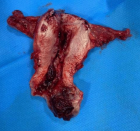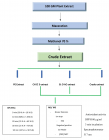Abstract
Research Article
A retrospective cohort study to evaluate the relationship of airway hyperresponsiveness to type 2 biomarkers in persistent asthma
Rory Chan, Chris RuiWen Kuo and Brian Lipworth*
Published: 17 February, 2021 | Volume 5 - Issue 1 | Pages: 008-013
Airway hyperresponsiveness (AHR) is a hallmark of persistent asthma measured using direct or indirect airway bronchial challenge testing. The purpose of this study is to investigate the putative relationships between type 2 inflammatory biomarkers, airway geometry (FEV1 and FEF25-75) and specific IgE (RAST or skin prick) to AHR. We performed a retrospective analysis of our database (n = 131) of patients with asthma. Of these subjects, 75 had a histamine challenge and 56 had a mannitol challenge. Fractional exhaled nitric oxide (FeNO) and specific immunoglobulin E (IgE) but not blood eosinophils were significantly higher in patients with AHR to either histamine or mannitol. FEV1 % and FEF25 - 75 % were significantly lower in patients with AHR. Elevated Type 2 biomarkers including FeNO and specific IgE but not blood eosinophils were associated with AHR.
Highlights: FeNO and specific IgE but not blood eosinophils are raised in patients with airway hyperresponsiveness.
Read Full Article HTML DOI: 10.29328/journal.aaai.1001023 Cite this Article Read Full Article PDF
Keywords:
Airway hyperresponsiveness; Asthma; Allergy; Type 2 inflammation; FeNO
References
- Joos GF, O'Connor B, Anderson SD, Chung F, Cockcroft DW, et al. Indirect airway challenges. Eur Respir J. 2003; 21: 1050-1068. PubMed: https://pubmed.ncbi.nlm.nih.gov/12797503/
- Anderson SD. Bronchial challenge tests: usefulness, availability and limitations. Breathe. 2011; 8: 53-60.
- O'Byrne PM, Inman MD. Airway hyperresponsiveness. Chest. 2003; 123(3 Suppl): 411s-416s. PubMed: https://pubmed.ncbi.nlm.nih.gov/12629006/
- Busse WW. The relationship of airway hyperresponsiveness and airway inflammation: Airway hyperresponsiveness in asthma: its measurement and clinical significance. Chest. 2010; 138(2 Suppl): 4s-10s. PubMed: https://pubmed.ncbi.nlm.nih.gov/20668012/
- Laprise C, Laviolette M, Boutet M, Boulet L. Asymptomatic airway hyperresponsiveness: relationships with airway inflammation and remodelling. Eur Respir J. 1999; 14: 63-73. PubMed: https://pubmed.ncbi.nlm.nih.gov/10489830/
- Schwartz N, Grossman A, Levy Y, Schwarz Y. Correlation between Eosinophil Count and Methacholine Challenge Test in Asymptomatic Subjects. J Asthma. 2012; 49: 336-341. PubMed: https://pubmed.ncbi.nlm.nih.gov/22715867/
- Jatakanon A, Lim S, Kharitonov SA, Chung KF, Barnes PJ. Correlation between exhaled nitric oxide, sputum eosinophils, and methacholine responsiveness in patients with mild asthma. Thorax. 1998; 53: 91-95. PubMed: https://pubmed.ncbi.nlm.nih.gov/9624291/
- Juniper EF, Frith PA, Hargreave FE. Airway responsiveness to histamine and methacholine: relationship to minimum treatment to control symptoms of asthma. Thorax. 1981; 36: 575-579. PubMed: https://pubmed.ncbi.nlm.nih.gov/7031972/
- Peat JK, Woolcock AJ, Cullen K. Rate of decline of lung function in subjects with asthma. Eur J Respir Dis. 1987; 70: 171-179. PubMed: https://pubmed.ncbi.nlm.nih.gov/3569449/
- Fowler SJ, Dempsey OJ, Sims EJ, Lipworth BJ. Screening for bronchial hyperresponsiveness using methacholine and adenosine monophosphate. Relationship to asthma severity and beta(2)receptor genotype. Am J Respir Crit Care Med. 2000; 162: 1318-1322. PubMed: https://pubmed.ncbi.nlm.nih.gov/11029338/
- Miller MR, Hankinson J, Brusasco V, Burgos F, Casaburi R, Coates A, et al. Standardisation of spirometry. Eur Respir J. 2005; 26: 319-338. PubMed: https://pubmed.ncbi.nlm.nih.gov/16055882/
- Heinzerling L, Mari A, Bergmann KC, Bresciani M, Burbach G, et al. The skin prick test – European standards. Clin Transl Allergy. 2013; 3: 3. PubMed: https://pubmed.ncbi.nlm.nih.gov/23369181/
- ATS/ERS recommendations for standardized procedures for the online and offline measurement of exhaled lower respiratory nitric oxide and nasal nitric oxide, 2005. Am J Respir Crit Care Med. 2005; 171: 912-930. PubMed: https://pubmed.ncbi.nlm.nih.gov/15817806/
- Currie GP, Haggart K, Brannan JD, Lee DKC, Anderson SD, et al. Relationship between airway hyperresponsiveness to mannitol and adenosine monophosphate. Allergy. 2003; 58: 762-766. PubMed: https://pubmed.ncbi.nlm.nih.gov/12859555/
- Manoharan A, Lipworth BJ, Craig E, Jackson C. The potential role of direct and indirect bronchial challenge testing to identify overtreatment of community managed asthma. Clin Exp Allergy. 2014; 44: 1240-1245. PubMed: https://pubmed.ncbi.nlm.nih.gov/24912796/
- Wilson AM, Lipworth BJ. Dose-response evaluation of the therapeutic index for inhaled budesonide in patients with mild-to-moderate asthma. Am J Med. 2000; 108: 269-275. PubMed: https://pubmed.ncbi.nlm.nih.gov/11014718/
- Currie GP, Fowler SJ, Lipworth BJ. Dose response of inhaled corticosteroids on bronchial hyperresponsiveness: A meta-analysis. Ann Allergy Asthma Immunol. 2003; 90: 194-198. PubMed: https://pubmed.ncbi.nlm.nih.gov/12602665/
- Zietkowski Z, Bodzenta-Lukaszyk A, Tomasiak MM, Skiepko R, Szmitkowski M. Comparison of exhaled nitric oxide measurement with conventional tests in steroid-naive asthma patients. J Investig Allergol Clin Immunol. 2006; 16: 239-246. PubMed: https://pubmed.ncbi.nlm.nih.gov/16889281/
- Sverrild A, Porsbjerg C, Thomsen SF, Backer V. Airway hyperresponsiveness to mannitol and methacholine and exhaled nitric oxide: a random-sample population study. J Allergy Clin Immunol. 2010; 126: 952-958. PubMed: https://pubmed.ncbi.nlm.nih.gov/20934208/
- Lipworth BJ, Short PM, Williamson PA, Clearie KL, Fardon TC, et al. A randomized primary care trial of steroid titration against mannitol in persistent asthma: STAMINA trial. Chest. 2012; 141: 607-615. PubMed: https://pubmed.ncbi.nlm.nih.gov/21998259/
- Jabbal S, Lipworth BJ. Blood eosinophils: The forgotten man of inhaled steroid dose titration. Clin Exp Allergy. 2018; 48: 93-95. PubMed: https://pubmed.ncbi.nlm.nih.gov/29117628/
- Chan R, RuiWen Kuo C, Lipworth B. Pragmatic Clinical Perspective on Biologics for Severe Refractory Type 2 Asthma. J Allergy Clin Immunol Pract. 2020; 8: 3363-3370. PubMed: https://pubmed.ncbi.nlm.nih.gov/32673880/
- Meurs H, Gosens R, Zaagsma J. Airway hyperresponsiveness in asthma: lessons from in vitro model systems and animal models. Eur Respir J. 2008; 32: 487-502. PubMed: https://pubmed.ncbi.nlm.nih.gov/18669789/
- Sont JK, Willems LN, Bel EH, van Krieken JH, Vandenbroucke JP, Sterk PJ. Clinical control and histopathologic outcome of asthma when using airway hyperresponsiveness as an additional guide to long-term treatment. The AMPUL Study Group. Am J Respir Crit Care Med. 1999; 159: 1043-1051. PubMed: https://pubmed.ncbi.nlm.nih.gov/10194144/
- Britton J, Hanley SP, Garrett HV, Hadfield JW, Tattersfield AE. Dose related effects of salbutamol and ipratropium bromide on airway calibre and reactivity in subjects with asthma. Thorax. 1988; 43: 300-305. PubMed: https://pubmed.ncbi.nlm.nih.gov/2970125/
- Suh DI, Koh YY. Relationship between atopy and bronchial hyperresponsiveness. Allergy Asthma Immunol Res. 2013; 5: 181-188. PubMed: https://www.ncbi.nlm.nih.gov/pmc/articles/PMC3695231/
- Lipworth BJ, Jabbal S. Un-diagnosing persistent adult asthma. Eur Respir J. 2017; 50: 1701433. PubMed: https://pubmed.ncbi.nlm.nih.gov/29097435/
Figures:

Figure 1

Figure 2
Similar Articles
-
The effects of early low dose exposures to the Environmental Estrogen Bisphenol A on the Development of Childhood AsthmaTerumi Midoro-Horiuti*,Randall M Goldblum. The effects of early low dose exposures to the Environmental Estrogen Bisphenol A on the Development of Childhood Asthma. . 2017 doi: 10.29328/journal.haard.1001003; 1: 015-027
-
Prevalence of reported drug allergy and its impact on Beta lactam use with financial and health implicationsJoanna Lukawska*,Abirami Murugesh-Warre#,Ranu Malhin#,Yogini Jani,Christopher Corrigan,David Walker,Harsha Kariyawasam. Prevalence of reported drug allergy and its impact on Beta lactam use with financial and health implications. . 2017 doi: 10.29328/journal.haard.1001004; 1: 028-035
-
Inducible Laryngeal Obstruction/Vocal Cord Dysfunction and the Role It Plays in Refractory AsthmaJay I Peters*,Jorge Villalpando,Sandra G Adams. Inducible Laryngeal Obstruction/Vocal Cord Dysfunction and the Role It Plays in Refractory Asthma. . 2017 doi: 10.29328/journal.haard.1001005; 1: 036-039
-
Chemo-cytokines network is main target for control of Allergic asthmaSeyyed Shamsadin Athari*,Seyyede Masoume Athari. Chemo-cytokines network is main target for control of Allergic asthma. . 2018 doi: 10.29328/journal.aaai.1001009; 2: 001-002
-
Role of Serum Magnesium levels in Asthmatic with childrenSomashekar AR*,Ramakrishnan KG,Seyyed Vanitha Gowda. Role of Serum Magnesium levels in Asthmatic with children. . 2018 doi: 10.29328/journal.aaai.1001010; 2: 003-005
-
Interplay between asthma and gastroesophageal reflux disease: A controversial issueYiannakopoulou Eugenia*. Interplay between asthma and gastroesophageal reflux disease: A controversial issue. . 2018 doi: 10.29328/journal.aaai.1001011; 2: 006-007
-
Diagnosis of Asthma in Childhood AgeIbrahim A Ali*,Elia Adil Nabih,Ahmed MS Eltohami. Diagnosis of Asthma in Childhood Age . . 2018 doi: 10.29328/journal.aaai.1001012; 2: 008-012
-
Pneumothorax, pneumomediastinum, subcutaneous emphysema: serious complications of asthmaYiannakopoulou E*. Pneumothorax, pneumomediastinum, subcutaneous emphysema: serious complications of asthma . . 2018 doi: 10.29328/journal.aaai.1001014; 2: 016-017
-
Allergic Asthma and Sick building syndromeSeyyed Shamsadin Athari*. Allergic Asthma and Sick building syndrome . . 2019 doi: 10.29328/journal.aaai.1001015; 3: 001-002
-
Biologic therapy in severe asthma: An updateMaha A Al Ammari*. Biologic therapy in severe asthma: An update. . 2019 doi: 10.29328/journal.aaai.1001016; 3: 003-009
Recently Viewed
-
Changes in the frequency and intensity of Tinnitus using the Suppressive Noise SpectrumMing Zhang*,Alysia Jeske,Sarah Young. Changes in the frequency and intensity of Tinnitus using the Suppressive Noise Spectrum. Adv Treat ENT Disord. 2017: doi: 10.29328/journal.ated.1001002; 1: 006-012
-
Unusual Complications of a Dental Prosthesis Esophageal Foreign Body: About a CaseRichard Edward Alain Deguenonvo,Ndèye Fatou Thiam*,Mouhamadou Diouldé Diallo,Abdou Sy,Amadou Thiam,Abdoulaye Diop,Mame Sanou Diouf,Baye Karim Diallo. Unusual Complications of a Dental Prosthesis Esophageal Foreign Body: About a Case. Adv Treat ENT Disord. 2025: doi: 10.29328/journal.ated.1001016; 9: 001-004
-
Deep Learning-Powered Genetic Insights for Elite Swimming Performance: Integrating DNA Markers, Physiological Biometrics and Performance AnalyticsRahul Kathuria,Reeta Devi,Asadi Srinivasulu*. Deep Learning-Powered Genetic Insights for Elite Swimming Performance: Integrating DNA Markers, Physiological Biometrics and Performance Analytics. Int J Bone Marrow Res. 2025: doi: 10.29328/journal.ijbmr.1001020; 8: 006-015
-
Effectiveness of levocetirizine in treating allergic rhinitis while retaining work efficiencyDabholkar Yogesh, Shah Tanush, Rathod Roheet, Paspulate Akhila, Veligandla Krishna Chaitanya, Rathod Rahul, Devesh Kumar Joshi*, Kotak Bhavesh. Effectiveness of levocetirizine in treating allergic rhinitis while retaining work efficiency. Arch Asthma Allergy Immunol. 2023: doi: 10.29328/journal.aaai.1001031; 7: 005-011
-
The use of the scientific method as dogma can be an obstacle in times of pandemicFelipe Inserra,Walter Manucha*,León Ferder. The use of the scientific method as dogma can be an obstacle in times of pandemic. Insights Clin Cell Immunol. 2021: doi: 10.29328/journal.icci.1001016; 5: 001-002
Most Viewed
-
Causal Link between Human Blood Metabolites and Asthma: An Investigation Using Mendelian RandomizationYong-Qing Zhu, Xiao-Yan Meng, Jing-Hua Yang*. Causal Link between Human Blood Metabolites and Asthma: An Investigation Using Mendelian Randomization. Arch Asthma Allergy Immunol. 2023 doi: 10.29328/journal.aaai.1001032; 7: 012-022
-
Impact of Latex Sensitization on Asthma and Rhinitis Progression: A Study at Abidjan-Cocody University Hospital - Côte d’Ivoire (Progression of Asthma and Rhinitis related to Latex Sensitization)Dasse Sery Romuald*, KL Siransy, N Koffi, RO Yeboah, EK Nguessan, HA Adou, VP Goran-Kouacou, AU Assi, JY Seri, S Moussa, D Oura, CL Memel, H Koya, E Atoukoula. Impact of Latex Sensitization on Asthma and Rhinitis Progression: A Study at Abidjan-Cocody University Hospital - Côte d’Ivoire (Progression of Asthma and Rhinitis related to Latex Sensitization). Arch Asthma Allergy Immunol. 2024 doi: 10.29328/journal.aaai.1001035; 8: 007-012
-
An algorithm to safely manage oral food challenge in an office-based setting for children with multiple food allergiesNathalie Cottel,Aïcha Dieme,Véronique Orcel,Yannick Chantran,Mélisande Bourgoin-Heck,Jocelyne Just. An algorithm to safely manage oral food challenge in an office-based setting for children with multiple food allergies. Arch Asthma Allergy Immunol. 2021 doi: 10.29328/journal.aaai.1001027; 5: 030-037
-
Snow white: an allergic girl?Oreste Vittore Brenna*. Snow white: an allergic girl?. Arch Asthma Allergy Immunol. 2022 doi: 10.29328/journal.aaai.1001029; 6: 001-002
-
Cytokine intoxication as a model of cell apoptosis and predict of schizophrenia - like affective disordersElena Viktorovna Drozdova*. Cytokine intoxication as a model of cell apoptosis and predict of schizophrenia - like affective disorders. Arch Asthma Allergy Immunol. 2021 doi: 10.29328/journal.aaai.1001028; 5: 038-040

If you are already a member of our network and need to keep track of any developments regarding a question you have already submitted, click "take me to my Query."



















































































































































